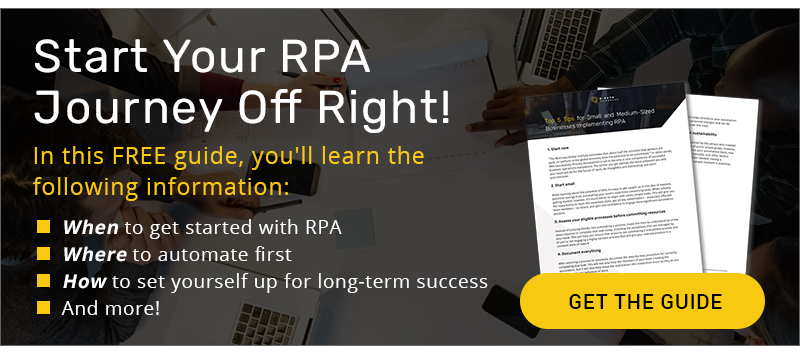An automation initiative is ultimately about results. The popularity of Robotic Process Automation (RPA) is due, in part, to widespread and real successes. For example, Leslie Willcocks, professor of technology, work, and globalization at The London School of Economics and Political Science’s Department of Management found an ROI between 30% and 200% in the first year in a review of 16 RPA projects.
The benefits of RPA go beyond hard numbers. According to Willcocks, “RPA takes the robot out of the human.” Advances in business operations can be dehumanizing; with RPA, however, the trend is reversed. RPA automates tedious and error-prone tasks so people can contribute in more meaningful ways.
“RPA takes the robot out of the human.”
Leslie Willcocks, The London School of Economics and Political Science
As you plan your automation initiative, consider both hard ROI and soft benefits. We’ll outline below two aspects of RPA metrics:
- Focusing on the initial stage, or “pilot” stage, to ensure that you have the fundamentals in place to help socialize automation throughout the organization, and
- Ensuring that you’ve considered all the ways that automation can improve operations and make a compelling case for change in your organization.
See our post on the 4 Stages of an Effective RPA Initiative for more information on pilots and an RPA program generally.
Start With a Compelling “Showcase” Success
The first project or pilot should be a showcase success or a project that helps you to share the concept of automation with people at all levels in the organization. The primary goal is to, “…establish credibility and help people become more comfortable with RPA within your organization.”
In considering your pilot project, focus on metrics for three, key audiences: senior leadership, peers, and the people directly affected by automation. Your leadership wants the showcase to deliver metrics that support a larger business case. Peers need to understand that adopting automation can help them achieve their department’s strategic objectives. The team members performing manual tasks need to experience improvements in their work lives. After all, RPA is About More Than Cost Savings.

A showcase success is:
- A way to validate assumptions for investing in RPA
- Achievable, discrete, and relatively short in duration
- Referenceable throughout the organization
The showcase success helps tell a story about the sorts of work that can be automated and the benefits that the organization and employees see. Measuring improvement is an indispensable part of that story.
Set up Baseline Measures for Manual Tasks
To measure improvement, of course, baseline measures for manual tasks need to be set up before you begin your pilot project. This advice may seem obvious; after all, you need to measure a baseline for any project, whether the showcase success or a later one. Stress baseline measures at an early stage to develop the habit of measuring manual activities. Manual tasks are often overlooked as a cost of doing business rather than a set of activities that can be quantified.
For example, employees who enter sales orders from one system, like email, into the billing system know that this manual step happens. Others in the organization may not be aware of the time and effort involved. That’s why creating a flow chart for an existing process is a surprising and beneficial exercise; people often have very different perceptions of the actual activities performed.
Once your automation program is established, creating baseline measures will be easier. At this early stage, you may not have ready tools for quantifying a baseline. Begin early to state assumptions and rough estimates about costs, time, effort, output, etc. for tasks.
Include the Metrics that Matter Most for Your Business
After successfully proving RPA in the pilot, you’ll want to prepare for a larger automation program. To select meaningful metrics for your program, consider both hard and soft benefits. You may get benefits in ways that you do not expect. Being prepared with meaningful metrics from multiple sources helps in quantifying and sharing these pleasant surprises.
Some common types of RPA benefits that can serve as a framework for creating your specific measures:
- Productivity—Divide units of output by units of input. How you determine these units depends on your business model and a solid understanding of the tasks and processes involved. For example, Radius Bank uses RPA to support growth. This growth is possible given the bank’s ability to onboard new customers faster.
- Cost savings—Of course, RPA creates efficiencies. Cost avoidance includes not hiring additional employees and not upgrading or replacing existing systems, as well as identifying and tallying the operating and capital costs that are reduced or eliminated with automation.
- Time savings—Time savings compare to time spent per activity before and after automation as well as the duration of the overall activity or larger steps in the process. Note that while time saved is attractive because it can be measured, some organizations don’t necessarily “save” the costs associated with an employee’s salary; a job is not a task. However, some organizations value employee efficiency so much that they assign a financial value to time savings. In other situations, the time savings may have some other effect, like increased output or better customer service.
- Accuracy improvement— By eliminating human error from activities, you’ll inevitably see improved quality and/or reduced errors. Be sure to understand the current error rate, which can be elusive, and mitigate human error in setting up and maintaining the automation. Often the human error in set up is in misunderstanding process exceptions that are not accounted for in the automation. A great example of the accuracy affecting hard measures is in compliance. In some situations, ensuring compliance avoids fines or, for health care providers, accelerates reimbursements from a payer.
- Improved security—Unfortunately, people are the greatest vulnerability risk in a security framework. Automation removes much of this type of risk and provides controls that can be inspected easily. An InfoSec group may have measures in place that you can adopt to track how automation helps improve vulnerability assessment scores.
- Employee satisfaction—The immediate opportunities for RPA will be in replacing menial tasks that people do not want to perform. Consider how to incorporate the effects of automation on employee satisfaction scores.
- Customer satisfaction— Look for reduced wait times and other process improvements that directly affect the customer experience. If your organization tracks customer satisfaction regularly through mechanisms like an NPS score, work with the team to see if they can identify improvements that might be attributed to faster service and fewer mistakes.
- Top-line improvement—Similarly, consider how automating certain tasks improves efficiencies in revenue generation and produces better margins.
- RPA adoption—While not a primary metric, it is helpful to track the spread of automation throughout your organization in order to understand the cumulative effect of the technology in improving your business.
As with any metrics initiative, align with Finance and/or the official metrics function(s) in your organization to ensure that your measures follow accepted definitions and data. Expanding the benefits of automation will be easier and more compelling when your terms are clear and aligned with norms within your organization.
Understanding Metrics with Two Examples
To illustrate the benefits of automation, let’s review two real examples of RPA projects that were completed early in a company’s automation initiative. The first is in health care and the second is in banking.
HEALTH CARE BENEFITS OF AUTOMATION
Entering Data in an Electronic Health Record (EHR)—Before automation, therapists and counselors at a behavioral health and substance abuse treatment center manually entered group session attendance information into their EHR to ensure proper billing and care plan compliance.
- Productivity—With RPA, the task is scalable. The number of clients no longer affects the time required for data entry.
- Time savings—The treatment center saved 1,560 hours per year. Based on an average cost per FTE, the ROI for this specific automation was achieved in less than four months.
- Accuracy improvement—The accuracy of the data entry was estimated to increase from ≈93% to 100%.
- Employee satisfaction—Therapists and counselors do not need to manually enter the data and can spend the time saved in supporting patients. Senior management has peace of mind because they know the task is performed accurately every day.
- Top-line improvement—With RPA, reimbursement claims are submitted daily, improving cash flow. With the manual process, data entry was not completed for every group session every day. (Please note that this benefit could be quantified.)
BANKING BENEFITS OF AUTOMATION
Closing external services with a bank account closure—Before automation, various bank employees closed access to external systems—such as electronic statements and bill pay services—when a checking account was closed.
- Productivity—With RPA, the task is scalable. The number of account closures no longer affects the time required to close access to external services.
- Cost savings—The external systems incur a daily cost per client. With RPA, all external access was closed accurately every day, saving money. (Please note that this benefit could be quantified.)
- Time savings—The bank saved 780 hours per year by automating this one task. Based on an average cost per FTE, the ROI was achieved in just over one month.
- Employee satisfaction—Employees do not need to manually perform this tedious task. Senior management has peace of mind because they know the task is performed accurately every day.
Incorporate Data in Decision-making as a Practice
As a final note, make sure that you include metrics in day-to-day automation decisions in order to avoid the proverbial, “When you have a hammer, every problem looks like a nail.” When metrics are owned by your Center of Excellence and have executive support, you can feel confident that you’re getting the best return on your RPA investment. You will also have the ability to zoom out and assess corporate, department, and individual performance by automation improvements.

